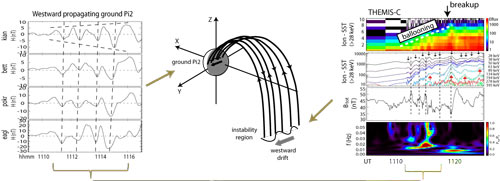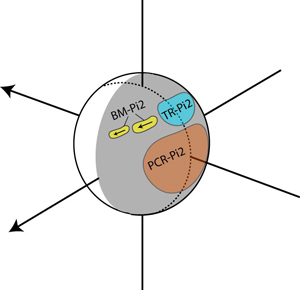
2012 THEMIS SCIENCE NUGGETS
Pi2 pulsations driven by ballooning instability
by Andreas Keiling, UC Berkeley, Space Sciences Lab
Introduction
Even though Pi2 research has a long history (over half a century), it is still a vigorously pursued field of magnetospheric physics that is of great interest to many, particularly the ULF and substorm communities. In the literature, various generation scenarios have been proposed to explain high-latitude Pi2 pulsations (Figure 1).
| Figure 1. Locations of potential Pi2 source regions (colored) inside the Earth’s magnetosphere. Each source region is associated with one or two Pi2 models. A source region is the place where a physical mechanism operates that establishes the Pi2 period, i.e., 40 – 150 s (From Keiling & Takahashi, 2011). |
On the basis of ground-based observations, some studies suggested that wave activity driven by plasma instabilities in the near-Earth plasma sheet, without specifying the instability mode and its coupling to the ionosphere, could cause ground Pi2 pulsations. On the other hand, several spacecraft-based studies reported wave activity in the Pi2 frequency band, but their causal relationship with ground Pi2 pulsations was not investigated. In this study we combine ground and in-situ observations to argue that ballooning modes are viable candidates for the generation of high-latitude Pi2 pulsations.
Results
Figure 2 shows one-to-one correlation between Pi2-like modulated particle fluxes (right) and ground magnetic fields (left) with a period of 60 s. On the ground and in space, westward propagation of the Pi2 was recorded at azimuthally-separated ground stations and three THEMIS spacecraft (note shown here), respectively. In addition, the space perturbations were diamagnetic and showed increasing energy flux until a major particle injection occurred. This suggests that the ballooning mode grew over several minutes until it led to breakup (i.e., particle injection and auroral intensification).
It was shown that the diamagnetic oscillations were westward drifting ripples on an energized plasma boundary, likely located in the transition region between dipole-like and tail-like magnetic field lines. The wavelength of the ripples (ballooning mode) had an azimuthal mode number of 40.
To connect the space and ground Pi2, a coupling was proposed in which upward and downward FACs connect perturbations of the drift ballooning mode structure with the westward propagating ground Pi2 (Figure 2, middle).
| Figure 2. Ground-space comparison of a Pi2 event: (Left) Ground magnetometer data (H component) from four Alaskan ground stations. The data are filtered (5 s, 100 s). The dashed lines emphasize the westward propagation of the Pi2. (Right) Particle and magnetic field data from THEMIS-C. (Middle) Illustration of the connection of the ground Pi2 and its source region in the magnetosphere. |
It is noted that a second Pi2 event with a different period and located farther west (Figure 3) was also correlated with plasma fluxes in a way similar to the first event. Hence, it can be concluded that at least two such instability regions existed simultaneously in the plasma sheet. Note that during the ballooning-driven Pi2s, the conventional Pi2s that are associated with the transient response model and the plasmaspheric cavity resonance were also present (Figure 3).
| Figure 3. Illustration of various Pi2 pulsations which were simultaneously present: TR-Pi2 (transient response), PCR-Pi2 (plasmaspheric cavity resonance), BM-Pi2 (ballooning mode). The arrows for the BM-Pi2s indicate westward propagation. |
Conclusion
With the evidence set forth in this study, we argue that ballooning modes are viable candidates for the generation of high-latitude Pi2 pulsations. In the scenario proposed here, it is the spatial separation of ballooning wave perturbations along an energized boundary in the near-Earth plasma sheet combined with a westward ion diamagnetic drift, which imprint a temporal signature, namely, Pi2 pulsation, on conjugate, stationary ground stations. The ballooning wave perturbations are connected via field-aligned currents to the ionosphere causing Pi2 perturbations in the ground magnetic field.
Three noteworthy, key observational features of this event are: (1) The spatial extent of the ballooning-driven Pi2 was small in latitude and longitude on the ground. (2) The drifting Pi2s at some ground stations occurred before the space Pi2, which is in reversed temporal order to what is typically expected. (3) Two plasma sheet regions were simultaneously ballooning-active, each causing different high-latitude Pi2s.
References
For more details see Keiling (2012), Pi2 pulsations driven by ballooning instability, J. Geophys. Res., 117, A03228, doi:10.1029/2011JA017223. A recent, comprehensive review that attempts to clarify the complex and sometimes confusing field of Pi2 research can be found in Keiling and Takahashi (2011), Review of Pi2 models, Space Sci. Rev. (2011) 161:63–148, doi: 10.1007/s11214-011-9818-4.
Biographical Note
Andreas Keiling is a research space physicist with the Space Sciences Laboratory at the University of California - Berkeley. His current research interests are magnetosphere-ionosphere coupling, ULF waves, and substorm/auroral dynamics.
 Please send comments/suggestions to
Emmanuel Masongsong / emasongsong @ igpp.ucla.edu
Please send comments/suggestions to
Emmanuel Masongsong / emasongsong @ igpp.ucla.edu


